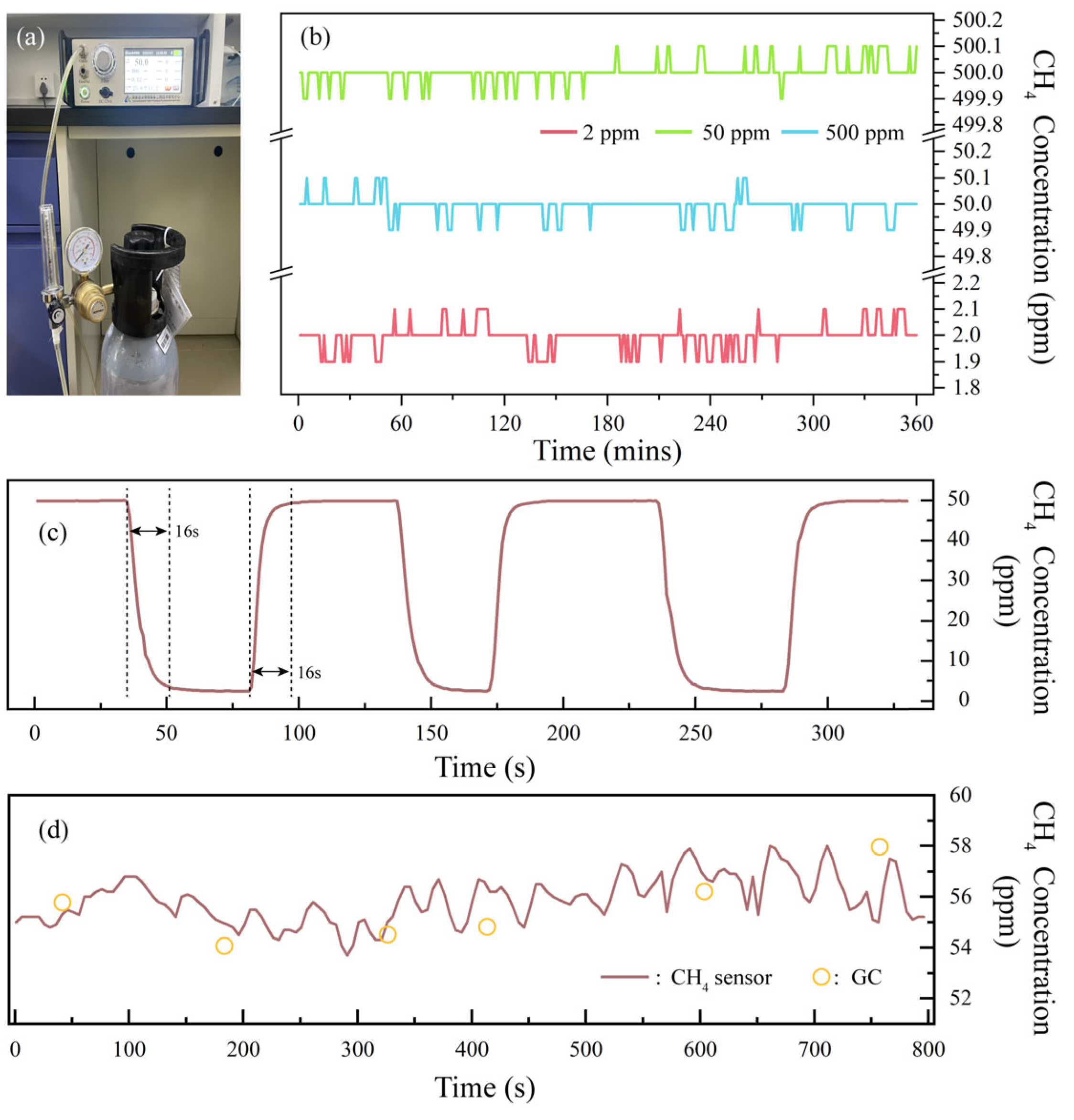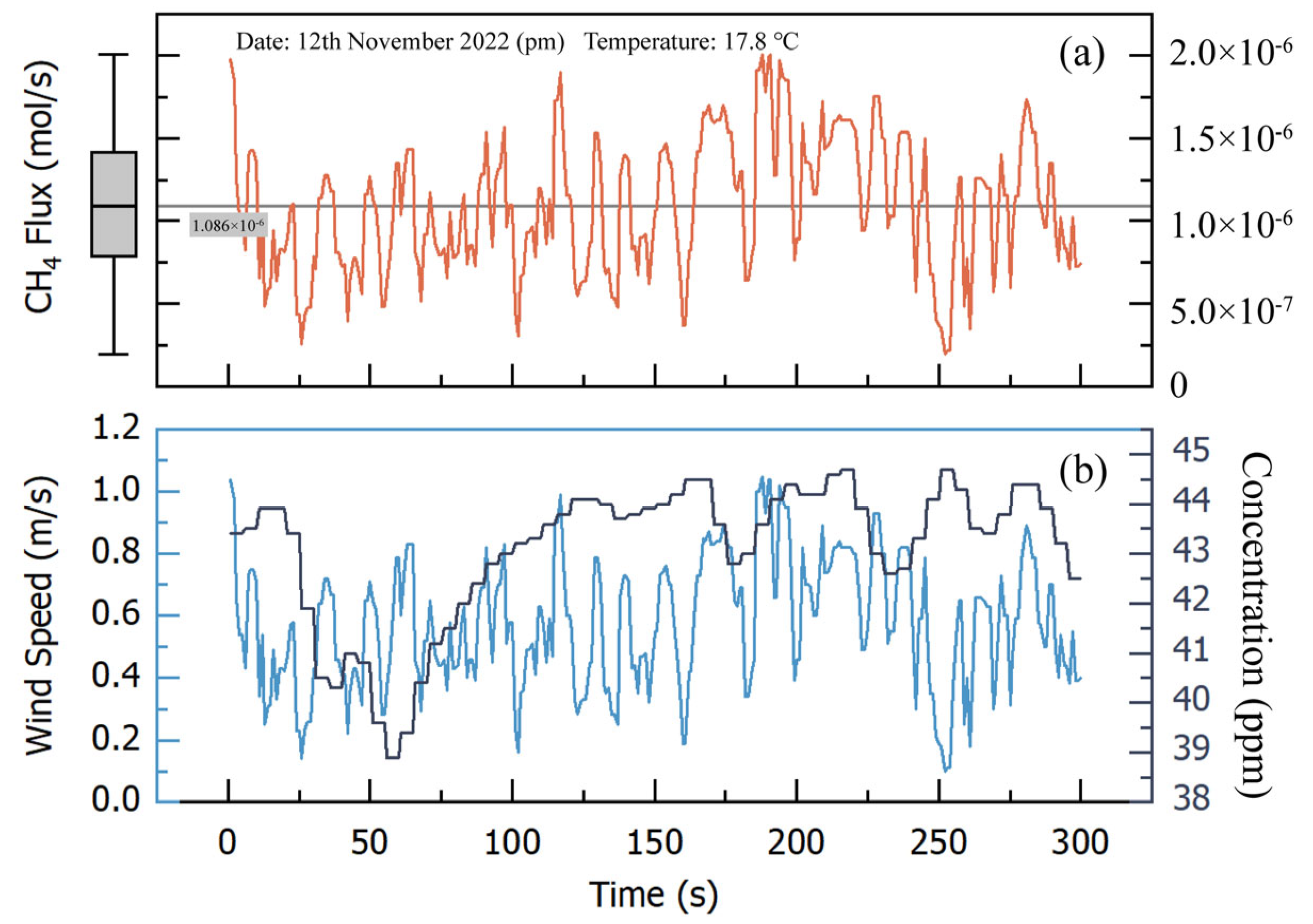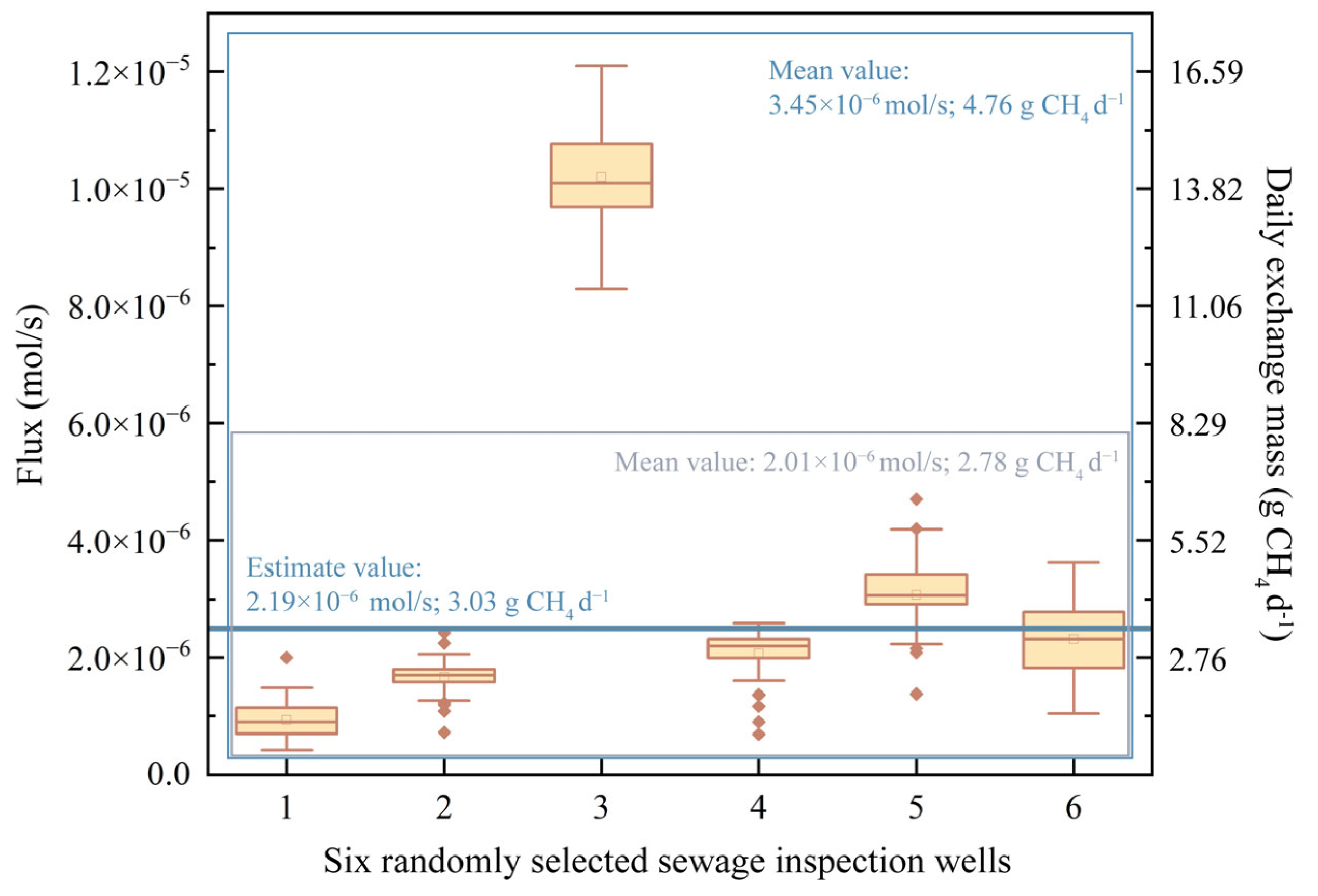Methane Exchange Flux Monitoring between Potential Source Sewage Inspection Wells and the Atmosphere Based on Laser Spectroscopy Method
Abstract
:1. Introduction
2. Materials and Methods
2.1. Research Location
2.2. Monitoring System
2.3. Flux Calculation Method
2.4. Estimation Method of Total Urban CH4 Exchange
3. Results and Discussion
3.1. In Situ Continuous Monitoring of the Exchange Flux
3.2. The Total Amount of CH4 Exchange in Sewage Inspection Wells in the Whole City
4. Conclusions
Author Contributions
Funding
Institutional Review Board Statement
Informed Consent Statement
Data Availability Statement
Conflicts of Interest
References
- Intergovernmental Panel on Climate Change. Climate Change 2014: Synthesis Report. Available online: https://www.ipcc.ch/site/assets/uploads/2018/05/SYR_AR5_FINAL_full_wcover.pdf (accessed on 18 October 2023).
- Wuebbles, D.J.; Hayhoe, K. Atmospheric Methane and Global Change. Earth Sci. Rev. 2002, 57, 177–210. [Google Scholar] [CrossRef]
- Hou, R.; Li, T.; Fu, Q.; Liu, D.; Li, M.; Zhou, Z.; Li, L.; Yan, J. Characteristics of Water–heat Variation and the Transfer Relationship in Sandy Loam under Different Conditions. Geoderma 2019, 340, 259–268. [Google Scholar] [CrossRef]
- Zhang, T.; Wu, S.; Fang, X.; Han, Z.; Li, S.; Wang, J.; Liu, S.; Zou, J. Spatiotemporal Variations of Dissolved CH4 Concentrations and Fluxes from Typical Freshwater Types in An Agricultural Irrigation Watershed in Eastern China. Environ. Pollut. 2022, 314, 120246. [Google Scholar] [CrossRef] [PubMed]
- Yamaji, K.; Ohara, T.; Akimoto, H. Regional-specific emission inventory for NH3, N2O, and CH4 via animal farming in South, Southeast, and East Asia. Atmos. Environ. 2004, 38, 7111–7121. [Google Scholar] [CrossRef]
- Zhu, T.; Bian, W.; Zhang, S.; Di, P.; Nie, B. An Improved Approach to Estimate Methane Emissions from Coal Mining in China. Environ. Sci. Technol. 2017, 51, 12072–12080. [Google Scholar] [CrossRef] [PubMed]
- Hu, N.; Liu, S.; Gao, Y.; Xu, J.; Zhang, X.; Zhang, Z.; Lee, X. Large Methane Emissions from Natural Gas Vehicles in Chinese Cities. Atmos. Environ. 2018, 187, 374–380. [Google Scholar] [CrossRef]
- Wang, J.; Li, Y.; Zhang, Y. Research on Carbon Emissions of Road Traffic in Chengdu City Based on A LEAP Model. Sustainability 2022, 14, 5625. [Google Scholar] [CrossRef]
- Wu, H.; Dong, L.; Yin, X.; Sampaolo, A.; Patimisco, P.; Ma, W.; Zhang, L.; Yin, W.; Xiao, L.; Spagnolo, V.; et al. Atmospheric CH4 Measurement Near A Landfill Using an ICL-based QEPAS Sensor with V-T Relaxation Self-calibration. Sens. Actuators B Chem. 2019, 297, 126753. [Google Scholar] [CrossRef]
- Masuda, S.; Suzuki, S.; Sano, I.; Li, Y.-Y.; Nishimura, O. The Seasonal Variation of Emission of Greenhouse Gases from A Full-scale Sewage Treatment Plant. Chemosphere 2015, 140, 167–173. [Google Scholar] [CrossRef]
- Gålfalk, M.; Påledal, S.N.; Sehlén, R.; Bastviken, D. Ground-based Remote Sensing of CH4 and N2O Fluxes from A Wastewater Treatment Plant and Nearby Biogas Production with Discoveries of Unexpected Sources. Environ. Res. 2022, 204, 111978. [Google Scholar] [CrossRef]
- Lu, L.; Li, X.; Li, Z.; Chen, Y.; Sabio-y-García, C.A.; Yang, J.; Luo, F.; Zou, X. Aerobic methanotrophs in an urban water cycle system: Community structure and network interaction pattern. Sci. Total Environ. 2021, 772, 145045. [Google Scholar] [CrossRef] [PubMed]
- Mulder, K. Future Options for Sewage and Drainage Systems Three Scenarios for Transitions and Continuity. Sustainability 2019, 11, 1383. [Google Scholar] [CrossRef]
- Lv, P.; Zhang, J.; Pang, L.; Yang, K.; Sun, S. Influence of Multiple Factors on the Explosion Characteristics of Flammable Gases in Municipal Sewage Pipelines. Adv. Civ. Eng. 2020, 2020, 3193012. [Google Scholar] [CrossRef]
- Eijo-Río, E.; Petit-Boix, A.; Villalba, G.; Suárez-Ojeda, M.E.; Marin, D.; Amores, M.J.; Aldea, X.; Rieradevall, J.; Gabarrell, X. Municipal sewer networks as sources of nitrous oxide, methane and hydrogen sulphide emissions: A review and case studies. J. Environ. Chem. Eng. 2015, 3, 2084–2094. [Google Scholar] [CrossRef]
- Fernandez, J.M.; Maazallahi, H.; France, J.L.; Menoud, M.; Corbu, M.; Ardelean, M.; Calcan, A.; Townsend-Small, A.; van der Veen, C.; Fisher, R.E.; et al. Street-level Methane Emissions of Bucharest, Romania and the Dominance of Urban Wastewater. Atmos. Environ. X 2022, 13, 100153. [Google Scholar] [CrossRef]
- Phillips, N.G.; Ackley, R.; Crosson, E.R.; Down, A.; Hutyra, L.R.; Brondfield, M.; Karr, J.D.; Zhao, K.; Jackson, R.B. Mapping Urban Pipeline Leaks: Methane Leaks Across Boston. Environ. Pollut. 2013, 173, 1–4. [Google Scholar] [CrossRef]
- Gålfalk, M.; Olofsson, G.; Bastviken, D.; Yamaji, K. Approaches for Hyperspectral Remote Flux Quantification and Visualization of GHGs in the Environment. Remote Sens. Environ. 2017, 191, 81–94. [Google Scholar] [CrossRef]
- Maier, M.; Weber, T.K.D.; Fiedler, J.; Fuß, R.; Glatzel, S.; Huth, V.; Jordan, S.; Jurasinski, G.; Kutzbach, L.; Schäfer, K.; et al. Introduction of A Guideline for Measurements of Greenhouse Gas Fluxes from Soils Using Non-steady-state Chambers. J. Plant Nutr. Soil Sci. 2022, 185, 447–461. [Google Scholar] [CrossRef]
- Williams, J.P.; El Hachem, K.; Kang, M. Controlled-release Testing of The Static Chamber Methodology for Direct Measurements of Methane Emissions. Atmos. Meas. Tech. Discuss. 2023, 16, 3421–3435. [Google Scholar] [CrossRef]
- Zhao, J.; Zhang, M.; Xiao, W.; Wang, W.; Zhang, Z.; Yu, Z.; Xiao, Q.; Cao, Z.; Xu, J.; Zhang, X.; et al. An Evaluation of The Flux-gradient and The Eddy Covariance Method to Measure CH4, CO2, and H2O Fluxes from Small Ponds. Agric. For. Meteorol. 2019, 275, 255–264. [Google Scholar] [CrossRef]
- Gålfalk, M.; Bastviken, M. Remote Sensing of Methane and Nitrous Oxide Fluxes from Waste Incineration. Waste Manag. 2018, 75, 319–326. [Google Scholar] [CrossRef] [PubMed]
- Engram, M.; Anthony, K.W.; Sachs, T.; Kohnert, K.; Serafimovich, A.; Grosse, G.; Meyer, F. Remote Sensing Northern Lake Methane Ebullition. Nat. Clim. Chang. 2020, 10, 511–517. [Google Scholar] [CrossRef]
- Zhu, Y.; Merbold, L.; Leitner, S.; Wolf, B.; Pelster, D.; Goopy, J.; Butterbach-Bahl, K. Interactive Effects of Dung Deposited onto Urine Patches on Greenhouse Gas Fluxes from Tropical Pastures in Kenya. Sci. Total Environ. 2021, 761, 143184. [Google Scholar] [CrossRef]
- Wang, W.; Sardans, J.; Wang, C.; Zeng, C.; Tong, C.; Asensio, D.; Penuelas, J. Relationships Between the Potential Production of the Greenhouse Gases CO2, CH4 and N2O and Soil Concentrations of C, N and P Across 26 Paddy Fields in Southeastern China. Atmos. Environ. 2017, 164, 458–467. [Google Scholar] [CrossRef]
- Tang, A.C.I.; Stoy, P.C.; Hirata, R.; Musin, K.K.; Aeries, E.B.; Wenceslaus, J.; Melling, L. Eddy Covariance Measurements of Methane Flux at A Tropical Peat Forest in Sarawak, Malaysian Borneo. Geophys. Res. Lett. 2018, 45, 4390–4399. [Google Scholar] [CrossRef]
- Lauvaux, T.; Giron, C.; Mazzolini, M.; d’Aspremont, A.; Duren, R.; Cusworth, D.; Shindell, D.; Ciais, P. Global Assessment of Oil and Gas Methane Ultra-emitters. Science 2022, 375, 557–561. [Google Scholar] [CrossRef] [PubMed]
- Krommweh, M.S.; Schmithausen, A.J.; Deeken, H.F.; Büscher, W.; Maack, G.-C. A New Experimental Setup for Measuring Greenhouse Gas and Volatile Organic Compound Emissions of Silage During the Aerobic Storage Period in A Special Silage Respiration Chamber. Environ. Pollut. 2020, 257, 115513. [Google Scholar] [CrossRef]
- Shah, A.; Willis, J.; Fillmore, L. Quantifying Methane Evolution from Sewers: Results from WERF/Dekalb phase 2 Continuous Monitoring at Honey Creek Pumping Station and Force Main. In Proceedings of the Water Environment Federation, Raleigh, NC, USA, 12–15 June 2011; Water Environment Federation: Alexandria, VA, USA, 2011; pp. 475–485. [Google Scholar]
- Fries, A.E.; Schifman, L.A.; Shuster, W.D.; Townsend-Small, A. Street-level Emissions of Methane and Nitrous Xxide from the Wastewater Collection System in Cincinnati, Ohio. Environ. Pollut. 2018, 236, 247–256. [Google Scholar] [CrossRef]
- Zhang, L.; Song, L.; Wang, B.; Shao, H.; Zhang, L.; Qin, X. Co-effects of Salinity and Moisture on CO2 and N2O Emissions of Laboratory-incubated Salt-affected Soils from Different Vegetation Types. Geoderma 2018, 332, 109–120. [Google Scholar] [CrossRef]
- Zhang, G.; Xiao, X.; Dong, J.; Xin, F.; Zhang, Y.; Qin, Y.; Doughty, R.B.; Moore, B. Fingerprint of Rice Paddies in Spatial–temporal Dynamics of Atmospheric Methane Concentration in Monsoon Asia. Nat. Commun. 2020, 11, 554. [Google Scholar] [CrossRef]
- Wang, Y.; Zhang, Y.; Zhao, C.; Dong, D.; Wang, K. CO and CH4 Atmospheric Trends from Dense Multi-point Forest Fires Around the City of Chongqing using Spaceborne Spectrometer Data. Atmos. Pollut. Res. 2023, 14, 101807. [Google Scholar] [CrossRef]
- Fu, B.; Zhang, C.; Lyu, W.; Sun, J.; Shang, C.; Cheng, Y.; Xu, L. Recent Progress on Laser Absorption Spectroscopy for Determination of Gaseous Chemical Species. Appl. Spectrosc. Rev. 2022, 57, 112–152. [Google Scholar] [CrossRef]
- Li, J.; Yu, Z.; Du, Z.; Ji, Y.; Liu, C. Standoff Chemical Detection Using Laser Absorption Spectroscopy: A Review. Remote Sens. 2020, 12, 2771. [Google Scholar] [CrossRef]
- Witzel, O.; Klein, A.; Meffert, C.; Wagner, S.; Kaiser, S.; Schulz, C.; Ebert, V. VCSEL-based, High-speed, in situ TDLAS for In-cylinder Water Vapor Measurements in IC Engines. Opt. Express 2013, 21, 19951–19965. [Google Scholar] [CrossRef] [PubMed]
- Jiao, L.; Dong, D.; Han, P.; Zhao, X.; Du, X. Identification of the Mango Maturity Level by the Analysis of Volatiles Based on Long Optical-path FTIR Spectroscopy and A Molecular Sieve. Anal. Methods 2017, 9, 2458–2463. [Google Scholar] [CrossRef]
- Zhang, Y.; Nie, Y.; Liu, Y.; Huang, X.; Yang, Y.; Xiong, H.; Zhu, H.; Li, Y. Characteristics of Greenhouse Gas Emissions from Yellow Paddy Soils under Long-Term Organic Fertilizer Application. Sustainability 2022, 14, 12574. [Google Scholar] [CrossRef]
- Machacova, K.; Vainio, E.; Urban, O.; Pihlatie, M. Seasonal dynamics of Stem N2O Exchange Follow the Physiological Activity of Boreal Trees. Nat. Commun. 2019, 10, 4989. [Google Scholar] [CrossRef]
- Tirol-Padre, A.; Rai, M.; Gathala, M.; Sharma, S.; Kumar, V.; Sharma, P.C.; Sharma, D.K.; Wassmann, R.; Ladha, J. Assessing the Performance of the Photo-acoustic Infrared Gas Monitor for Measuring CO2, N2O, and CH4 Fluxes in Two Major Cereal Rotations. Glob. Change Biol. 2014, 20, 287–299. [Google Scholar] [CrossRef]
- Guo, Y.; Qiu, X.; Li, N.; Feng, S.; Cheng, T.; Liu, Q.; He, Q.; Kan, R.; Yang, H.; Li, C. A Portable Laser-based Sensor for Detecting H2S in Domestic Natural Gas. Infrared Phys. Technol. 2020, 105, 103153. [Google Scholar] [CrossRef]
- Jońca, J.; Pawnuk, M.; Bezyk, Y.; Arsen, A.; Sówka, I. Drone-Assisted Monitoring of Atmospheric Pollution-A Comprehensive Review. Sustainability 2022, 14, 11516. [Google Scholar] [CrossRef]
- Dong, D.; Jiao, L.; Li, C.; Zhao, C. Rapid and Real-time Analysis of Volatile Compounds Released from Food Using Infrared and Laser Spectroscopy. Trends Analyt. Chem. 2019, 110, 410–416. [Google Scholar] [CrossRef]
- Wang, K.; Guo, R.; Zhou, Y.; Jiao, L.; Dong, D. Detection of NH3 in Poultry Housing Based on Tunable Diode Laser Absorption Spectroscopy Combined with A Micro Circular Absorption Cell. Front. Phys. 2022, 10, 1051719. [Google Scholar] [CrossRef]
- Efron, B.; Tibshirani, R. Bootstrap Methods for Standard Errors, Confidence Intervals, and Other Measures of Statistical Accuracy. Stat. Sci. 1986, 1, 54–75. [Google Scholar] [CrossRef]
- Rothman, L.S.; Gordon, I.E.; Babikov, Y.; Barbe, A.; Benner, D.C.; Bernath, P.F.; Birk, M.; Bizzocchi, L.; Boudon, V.; Brown, L.R.; et al. The HITRAN 2012 Molecular Spectroscopic Database. J. Quant. Spectrosc. Radiat. Transf. 2013, 130, 4–50. [Google Scholar] [CrossRef]
- Schilt, S.; Thévenaz, L.; Robert, P. Wavelength Modulation Spectroscopy: Combined Frequency and Intensity Laser Modulation. Appl. Opt. 2003, 42, 6728–6738. [Google Scholar] [CrossRef] [PubMed]
- Lin, S.; Chang, J.; Sun, J.; Xu, P. Improvement of the Detection Sensitivity for Tunable Diode Laser Absorption Spectroscopy: A Review. Front. Phys. 2022, 10, 853966. [Google Scholar] [CrossRef]
- Mangold, M.; Tuzson, B.; Hundt, M.; Jágerská, J.; Looser, H.; Emmenegger, L. Circular Paraboloid Reflection Cell for Laser Spectroscopic Trace Gas Analysis. J. Opt. Soc. Am. 2016, 33, 913–919. [Google Scholar] [CrossRef]
- Guisasola, A.; de Haas, D.; Keller, J.; Yuan, Z. Methane Formation in Sewer Systems. Water Res. 2008, 42, 1421–1430. [Google Scholar] [CrossRef]
- Hartley, K.; Lant, P. Eliminating Non-renewable CO2 Emissions from Sewage Treatment: An Anaerobic Migrating Bed Reactor Pilot Plant Study. Biotechnol. Bioeng. 2006, 95, 384–398. [Google Scholar] [CrossRef]
- Tenny, K.M.; Cooper, J.S. Ideal Gas Behavior; StatPearls Publishing: Treasure Island, FL, USA, 2017. [Google Scholar]
- Jhun, M.; Jeong, H.-C. Applications of Bootstrap Methods for Categorical Data Analysis. Comput. Stat. Data Anal. 2000, 35, 83–91. [Google Scholar] [CrossRef]
- Kallistova, A.Y.; Sabrekov, A.F.; Goncharov, V.M.; Pimenov, N.V.; Glagolev, M.V. On the Application of Statistical Analysis for Interpretation of Experimental Results in Environmental Microbiology. Microbiology 2019, 88, 232–239. [Google Scholar] [CrossRef]
- Wang, J.; Ma, C.; Wang, S.; Lu, X.; Li, D. Risk Assessment Model and Sensitivity Analysis of Ordinary Arterial Highways Based on RSR–CRITIC–LVSSM–EFAST. Sustainability 2022, 14, 16096. [Google Scholar] [CrossRef]
- Sun, J.; Hu, S.; Sharma, K.R.; Bustamante, H.; Yuan, Z. Impact of Reduced Water Consumption on Sulfide and Methane Production in Rising Main Sewers. J. Environ. Manag. 2015, 154, 307–315. [Google Scholar] [CrossRef]
- Lamb, B.K.; Edburg, S.L.; Ferrara, T.W.; Howard, T.; Harrison, M.R.; Kolb, C.E.; Townsend-Small, A.; Dyck, W.; Possolo, A.; Whetstone, J.R. Direct Measurements Show Decreasing Methane Emissions from Natural Gas Local Distribution Systems in the United States. Environ. Sci. Technol. 2015, 49, 5161–5169. [Google Scholar] [CrossRef] [PubMed]
- Hendrick, M.F.; Ackley, R.; Sanaie-Movahed, B.; Tang, X.; Phillips, N.G. Fugitive Methane Emissions from Leak-prone Natural Gas Distribution Infrastructure in Urban Environments. Environ. Pollut. 2016, 213, 710–716. [Google Scholar] [CrossRef] [PubMed]
- Von Sperling, M. Wastewater Characteristics, Treatment and Disposal; IWA Publishing: London, UK, 2007. [Google Scholar]
- Crippa, M.; Solazzo, E.; Huang, G.; Guizzardi, D.; Koffi, E.; Muntean, M.; Schieberle, C.; Friedrich, R.; Janssens-Maenhout, G. High Resolution Temporal Profiles in the Emissions Database for Global Atmospheric Research. Sci. Data 2020, 7, 121. [Google Scholar] [CrossRef]







Disclaimer/Publisher’s Note: The statements, opinions and data contained in all publications are solely those of the individual author(s) and contributor(s) and not of MDPI and/or the editor(s). MDPI and/or the editor(s) disclaim responsibility for any injury to people or property resulting from any ideas, methods, instructions or products referred to in the content. |
© 2023 by the authors. Licensee MDPI, Basel, Switzerland. This article is an open access article distributed under the terms and conditions of the Creative Commons Attribution (CC BY) license (https://creativecommons.org/licenses/by/4.0/).
Share and Cite
Wang, Y.; Zhao, X.; Dong, D.; Zhao, C.; Bao, F.; Guo, R.; Zhu, F.; Jiao, L. Methane Exchange Flux Monitoring between Potential Source Sewage Inspection Wells and the Atmosphere Based on Laser Spectroscopy Method. Sustainability 2023, 15, 16637. https://doi.org/10.3390/su152416637
Wang Y, Zhao X, Dong D, Zhao C, Bao F, Guo R, Zhu F, Jiao L. Methane Exchange Flux Monitoring between Potential Source Sewage Inspection Wells and the Atmosphere Based on Laser Spectroscopy Method. Sustainability. 2023; 15(24):16637. https://doi.org/10.3390/su152416637
Chicago/Turabian StyleWang, Yihao, Xiande Zhao, Daming Dong, Chunjiang Zhao, Feng Bao, Rui Guo, Fangxu Zhu, and Leizi Jiao. 2023. "Methane Exchange Flux Monitoring between Potential Source Sewage Inspection Wells and the Atmosphere Based on Laser Spectroscopy Method" Sustainability 15, no. 24: 16637. https://doi.org/10.3390/su152416637
APA StyleWang, Y., Zhao, X., Dong, D., Zhao, C., Bao, F., Guo, R., Zhu, F., & Jiao, L. (2023). Methane Exchange Flux Monitoring between Potential Source Sewage Inspection Wells and the Atmosphere Based on Laser Spectroscopy Method. Sustainability, 15(24), 16637. https://doi.org/10.3390/su152416637





